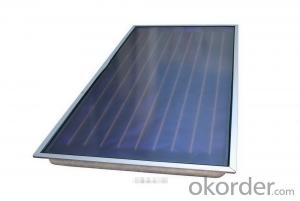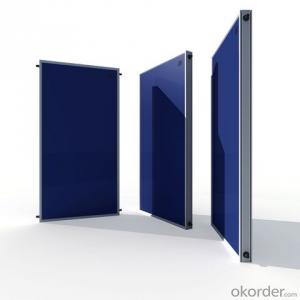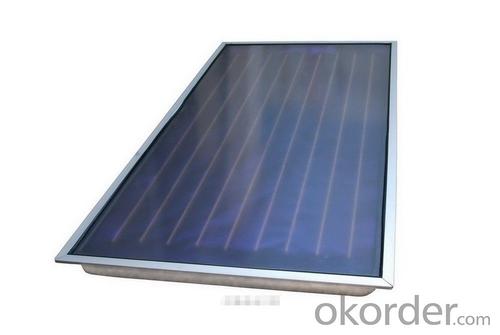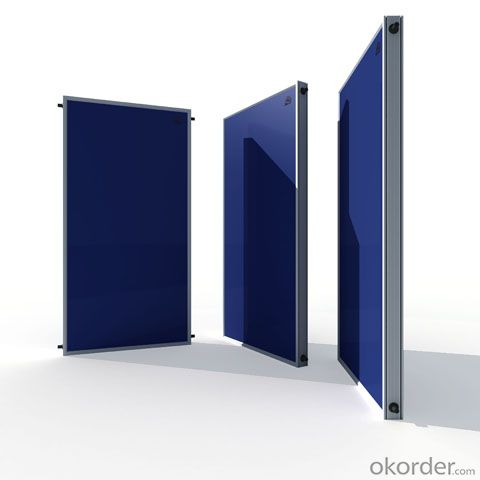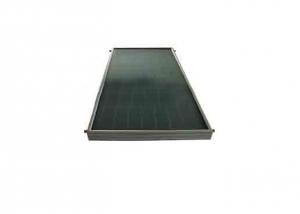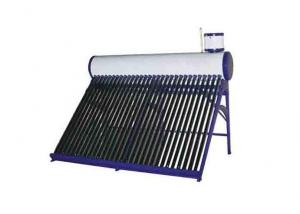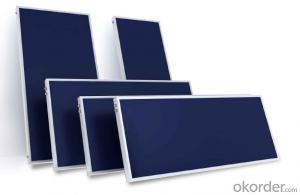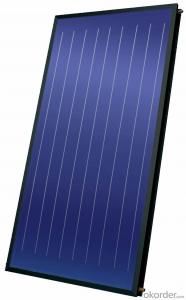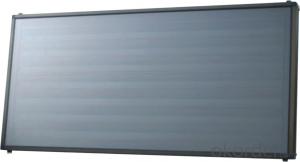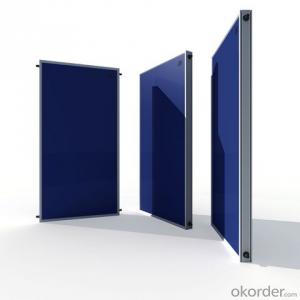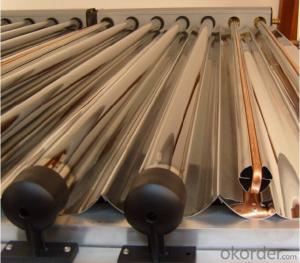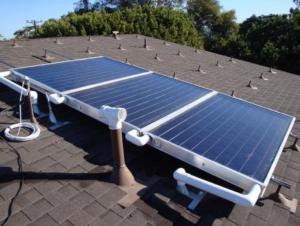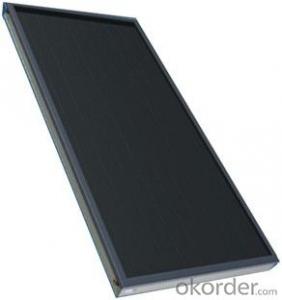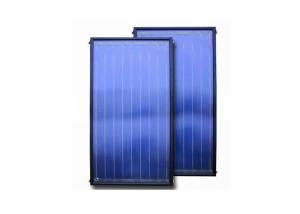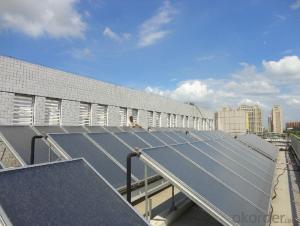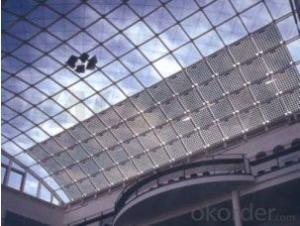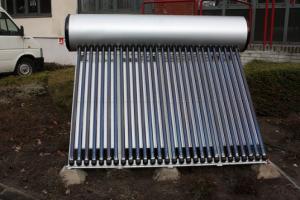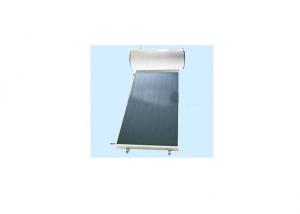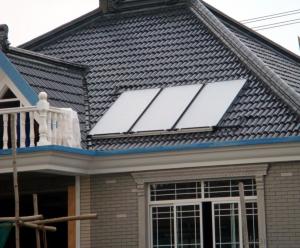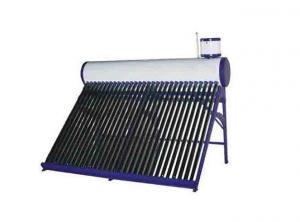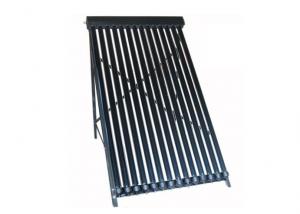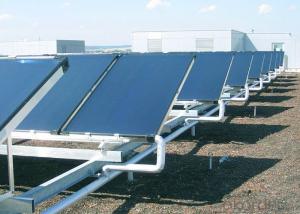Black Chrome Flat Panel Pool Solar Collectors
- Loading Port:
- Shanghai
- Payment Terms:
- TT OR LC
- Min Order Qty:
- 500 pc
- Supply Capability:
- 10000 pc/month
OKorder Service Pledge
OKorder Financial Service
You Might Also Like
Specifications
Flat panel solar thermal collector
Low iron tempered glass
Core: all Copper, ultrasonic welding.
Coating: black chrome
Flat panel solar thermal collector
consist of glazed, flat, dark surfaced absorber plate which contains copper tubing. The Plate absorbs incoming solar heat energy and the casing minimises heat loss. A fluid is circulated through the tubing and this fluid heats up as it passes by the absorber plate.
Feature:
1) Absorptance: ≥95%±2%.
2) Material:thickness:low iron rohbic tempered glass x thickness: 3.2mm.
3) Glass sheet size: 1988×988 mm.
4) Glass transmittance: 87%~91%.
6) Insulation material:Rock wool.
7) Back sheet material: Zincification plate0.3mm; embosseo Aluminum0.5mm.
8) Cross area: 2 m2.
9) Heat absorber area: 1.8 m2.
10) Fluid content: 2L.
11) Maximumpressure: 1 Mpa.
12) Operation temperature: -40~150°C.
Flat Plate Collectors
Flat plate collectors are the most common solar thermal collectors. They are most appropriate for low temperature applications, such as domestic hot water heating. Flat plate series water heaters maximizes solar heat gain, minimizes heat losses, and provides for the most efficient heat transfer from absorber plate to tube.
Flat Plate Solar Collectors are a glazed collectors which
feature a coating which maximizes heat absorption, aluminum framing which can withstand heavy weight and is weather resistant, and interior fiberglass insulation which allows for greater efficiency. The combination the latest energy efficiency technology and a strong heat exposure allow for optimal heat transfer and makes these lights the highest in BTU performance.
An important asset of flat plate solar collectors is their versatility. Their excellent efficiency makes them also suitable for the operation of larger systems for commercial or public use. Solar Flat Plate collectors are typically recommend for use in warmer climates simply because they are designed with larger absorber areas that are not insulated from the colder weather.
- Q: Can solar collectors be used for drying sports equipment?
- Solar collectors have the ability to dry sports equipment by harnessing energy from the sun and converting it into heat. This heat can effectively dry various items, including jerseys, gloves, helmets, and shoes, which often require drying to prevent bacterial growth and eliminate unpleasant odors. To utilize solar collectors for drying, one simply needs to place the sports equipment in a sunny area, allowing the collectors to absorb the sun's energy and convert it into heat. This heat will then evaporate any moisture present, effectively drying the equipment. This process is not only environmentally friendly but also eliminates the need for additional energy sources. Moreover, opting for solar collectors to dry sports equipment can lead to electricity savings and reduced energy costs. Instead of relying on energy-consuming electric dryers or heaters, solar collectors make use of freely available solar energy. It is important to consider that the efficiency of drying sports equipment using solar collectors may vary depending on factors such as sunlight intensity, ambient temperature, and moisture levels. However, with proper placement and optimization, solar collectors can be a reliable and sustainable solution for drying sports equipment.
- Q: Can solar collectors be used for generating electricity on warehouses?
- Yes, solar collectors can be used for generating electricity on warehouses. By installing solar panels on the roof of a warehouse, sunlight is captured and converted into electrical energy through photovoltaic cells. This enables the warehouse to generate clean and renewable electricity, reducing its reliance on traditional energy sources and lowering greenhouse gas emissions.
- Q: What is the impact of dust or dirt accumulation on the performance of solar collectors?
- The overall performance of solar collectors can be significantly affected by the accumulation of dust or dirt. To begin with, the presence of dust or dirt on the surface of solar collectors diminishes their ability to absorb sunlight. Consequently, less solar energy is converted into electricity, resulting in a decrease in overall energy output. A thin layer of dust alone can lower the efficiency of solar panels by up to 20%. Therefore, it is crucial to regularly clean and maintain solar collectors in order to ensure optimal performance. Additionally, the accumulation of dust or dirt creates a barrier between sunlight and the solar cells, reducing their electricity-generating capacity. This obstruction can also lead to increased heat on the surface of the panels, further decreasing their efficiency and lifespan. Moreover, excessive heat caused by dust or dirt build-up can raise the risk of hotspots, which can permanently damage the cells and degrade performance. Furthermore, the accumulation of dust or dirt can cause uneven shading on the surface of solar collectors. This shading effect disrupts the distribution of sunlight across the panels, causing different sections to generate varying amounts of electricity. As a result, the overall energy production of the solar collectors may be compromised. It is important to note that the impact of dust or dirt accumulation on solar collectors varies depending on the geographical location and prevailing weather conditions. Areas with high levels of airborne particles, such as deserts or industrial areas, are more prone to dust accumulation and thus experience a greater impact on the performance of solar collectors. Regular cleaning and maintenance are essential in mitigating the negative effects of dust or dirt accumulation on solar collectors. This can be accomplished through methods such as water rinsing, cleaning solutions, or automated cleaning systems. By ensuring that solar collectors are kept clean and free from dust or dirt, their performance can be maximized, resulting in higher energy production and increased longevity.
- Q: What is the payback period for a solar collector installation?
- The payback period for a solar collector installation varies depending on factors such as the initial cost of the installation, the amount of energy it generates, and the cost savings it provides. On average, a typical payback period for a solar collector installation ranges from 5 to 10 years. However, with government incentives and rising energy costs, the payback period can be significantly shorter, making solar collector installations a financially viable and sustainable investment.
- Q: Can solar collectors be used in areas with strict building codes?
- Yes, solar collectors can be used in areas with strict building codes. However, it is important to ensure that the design and installation of solar collectors comply with the specific requirements and regulations set forth by the building codes of the particular area. This may involve obtaining permits, adhering to height and setback restrictions, and following aesthetic guidelines to maintain the visual harmony of the neighborhood. By working closely with local authorities and professionals, it is possible to integrate solar collectors into buildings while meeting all necessary building code requirements.
- Q: Can solar collectors be used to heat swimming pools?
- Yes, solar collectors can be used to heat swimming pools. Solar collectors, such as solar panels or solar thermal systems, can absorb sunlight and convert it into heat energy, which can then be transferred to the swimming pool water through a circulation system. This helps to raise the temperature of the pool water, making it more comfortable for swimming and extending the swimming season without relying on traditional heating methods.
- Q: Can solar collectors be used in poverty alleviation programs?
- Yes, solar collectors can be used in poverty alleviation programs. Solar energy is a sustainable and clean source of power that can provide electricity and heating to communities in poverty. By implementing solar collectors, impoverished communities can have access to affordable and reliable energy, improving their living conditions, reducing their dependence on fossil fuels, and creating opportunities for economic growth and development.
- Q: What is the effect of saltwater exposure on solar collectors?
- Saltwater exposure can have a detrimental effect on solar collectors due to the corrosive nature of salt. It can cause damage to the materials, such as metal components and glass surfaces, leading to reduced efficiency and potential failure of the collectors over time. Regular maintenance and protective measures are necessary to mitigate the impact of saltwater exposure on solar collectors.
- Q: How do solar collectors affect visual aesthetics?
- Visual aesthetics can be influenced by solar collectors in both positive and negative ways. On one hand, these collectors have the potential to enhance the appearance of a building or landscape. Their sleek and modern designs can add a futuristic and eco-friendly touch, making a property more visually appealing. Additionally, the sight of solar collectors producing clean energy can symbolize progress and sustainability, further enhancing the visual appeal of an area. On the other hand, some individuals may find the presence of solar collectors unattractive or disruptive to the overall aesthetic. The size and bulkiness of traditional solar panels can be considered an eyesore, especially for those who prefer a more traditional or minimalist design. Furthermore, their placement on rooftops or in open spaces may obstruct views and alter the natural landscape, negatively impacting visual aesthetics. It is worth noting, however, that advancements in solar technology have resulted in more visually pleasing options. Solar tiles or shingles, for instance, seamlessly blend with traditional roofing materials, maintaining the overall aesthetic of a building while still generating energy. Moreover, solar collectors can be strategically positioned or integrated into architectural designs to minimize their visual impact, making them more acceptable for those concerned with aesthetics. Ultimately, the effect of solar collectors on visual aesthetics will vary depending on personal preferences, the design and placement of the collectors, and the overall context in which they are installed. As solar technology continues to progress, there is an increasing focus on seamlessly incorporating renewable energy solutions into the built environment, finding a balance between functionality and visual appeal.
- Q: How do solar collectors perform in areas with high levels of bird or insect activity?
- Solar collectors can be affected by high levels of bird or insect activity in certain ways. Birds and insects may occasionally perch or nest on the collectors, which can block sunlight from reaching the surface and reduce their efficiency. Additionally, bird droppings and insect debris can accumulate on the collectors, creating a film that further obstructs sunlight. This buildup can decrease the amount of energy captured by the collectors and, over time, reduce their overall performance. To mitigate these issues, there are a few measures that can be taken. One option is to install deterrents, such as spikes or netting, around the solar collectors to prevent birds from perching or nesting on them. This can help minimize the shading and debris accumulation caused by the bird activity. In the case of insects, regular cleaning and maintenance of the collectors can help remove any debris or buildup that may impede their performance. It is worth mentioning that not all bird or insect activity will have a significant impact on solar collectors. In areas with high levels of activity, it is recommended to assess the situation on a case-by-case basis and implement appropriate prevention measures accordingly. Overall, with proper maintenance and proactive steps to deter birds and insects, solar collectors can continue to perform effectively even in areas with high levels of activity.
Send your message to us
Black Chrome Flat Panel Pool Solar Collectors
- Loading Port:
- Shanghai
- Payment Terms:
- TT OR LC
- Min Order Qty:
- 500 pc
- Supply Capability:
- 10000 pc/month
OKorder Service Pledge
OKorder Financial Service
Similar products
Hot products
Hot Searches
Related keywords
